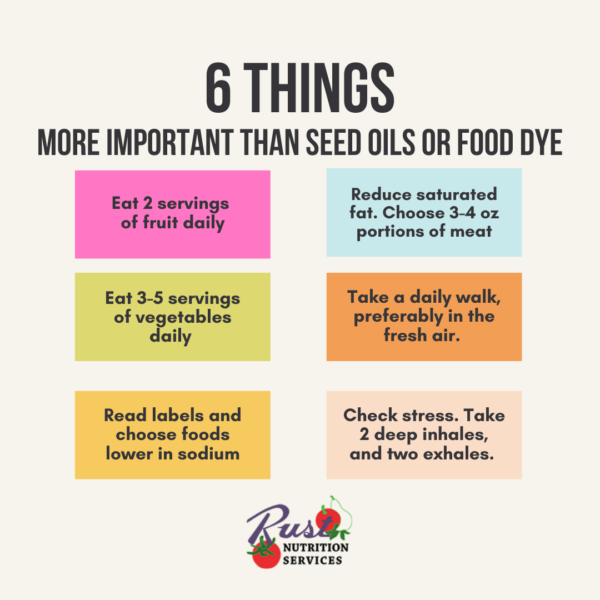Misinformation about food ingredients is a concern, and I fear it will be a continued trend in 2025.
Whether it’s about using “seed oils” (vegetable oils like canola, soybean, sunflower oils) or consuming foods with artificial food dyes, these topics have continued to cover your social media feed in distorted ways. Is there really a concern?
I’ve written about seed oils before, as have many of my colleagues. Social media personalities, many without any nutrition education or clinical background, like to hold on to one or two conspiracies and post outrage about them. The goal is generally to get your attention, instill fear about the topic or ingredient, and then lure you in to purchase their alternatives. Often times they are peddling nutrition supplements or maybe they are affiliated with an alternative brand.
Food Dyes
Food dyes are used by the food industry, and home cooks, to enhance the natural color of a food or product, or to add decoration and an element of fun to colorless foods (I don’t want to live in a world without colored sprinkles). Like oils, it’s the amount and frequency of the use of these types of products. The colorants are derived from both natural and synthetic sources. All color additives are approved by the FDA before they are used in food. The top three used are Red 40, Yellow 5 and Yellow 6. However the FDA is reconsidering Red dye 40, so we’ll see where that goes. Again, like dietary fat, it’s the total portion or amounts of food you consume with dyes that is the issue.

The totality of the evidence shows that food dyes do not cause cancer or any behavior issues. Overall, I don’t think food dyes are cause for alarm but I’d advise that you limit hyper-colored food or drink items, and instead, focus on whole foods. However enjoying a colored beverage, or colorful bowl of cereal, is not going to pose a health hazard. The issue is whether you are drinking three 16-ounce servings of a red beverage every day, or are you drinking a 16 ounce portion twice a week. That’s the difference – frequency and portion.
Reframing Your Year: Less Hype, More Focus
I’m not big on resolutions however I do believe in intention. Rather than worry about single ingredients, consider focusing on habits that really matter. Think about what you’d like to improve in your life. Rather than become fixated and fearful of the seed oils, food dyes, or some other ingredient in your diet, focus on some daily habits that have scientific evidence behind them, showing they support health and reduce disease risk.
6 habits to Improve Your Overall Health:
- Eat two or more servings of fruit daily. Choose the ones you enjoy, but consider including berries. Blueberries, raspberries and strawberries are a good source of Vitamin C and other antioxidants known to support brain and heart health. All types of fruit provides potassium, which helps regulate blood pressure.
- Include 3 to 5 servings of vegetables each day. This may seem like a lot, but a serving is approximately 1/2 cup. You may easily enjoy 2 servings in a side salad. You can add spinach to your morning eggs, add sliced tomatoes to sandwiches, roast vegetables to add to soups or chilis, and easily come up with 5 servings throughout the day.
- Read labels for sodium. Some people can handles larger amounts of sodium in the diet, but as you choose packaged foods, start checking the sodium content. Compare brands and choose the lower sodium option when possible. High sodium diets are a problem for people with high blood pressure (adding more fruits and veggies, and lowering sodium are the top habits for lowering blood pressure for people with hypertension).
- Eat less saturated fat. When you are glancing at the label, take a peak at saturated fat as well. Overall, less than 10 percent of your calories should provide saturated fat. When looking at the label, check the “Daily Value”. If it’s 20% or more, that food is high in saturated fat. Look for less than 5%. Research is ongoing in terms of the risk saturated fat may have on heart disease, but there is clear evidence that saturated fat raises “bad” cholesterol (LDL). Overall, it’s not as much about the type of fat, but the amount that is consumed. You may consider olive oil a healthier choice than butter or beef tallow, but you should still limit the amounts you consume. This means less fried food, less packaged bakery goods (often made with a saturated fat), and smaller portions of oils or butter used in cooking.
- Work in more daily movement. Taking a 30 minute walk everyday is a good habit. If you are out of shape, start slowly and gradually increase your pace over weeks. I recommend getting outside for fresh air whenever possible. Even if it’s only a 15 minute jaunt, the air and movement is good for you. Schedule your movement. It’s easy to make excuses for why you can’t fit it in. Put it on your calendar (Tuesday and Thursday mornings from 7:30-8:00am). Try to fit this into your morning, because there are less things that can interfere with it.
- Consider your stress. We all have stressors in our lives. Recognizing what you are having difficulty with, and then creating a plan to handle that stress is important to your overall health. Deep breathing exercises really help. When you are feeling overwhelmed, pause and take two to three deep breaths in, and exhales. This practice helps calm your body within minutes. If you are really struggling, reach out to a therapist or trusted family member or friend for support.




